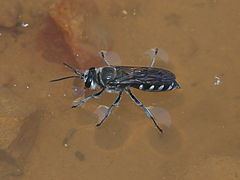Rank Genus | Subfamily Crabroninae | |
 | ||
Similar Tachysphex, Cryptocheilus australis, Sphictostethus nitidus, Crabroninae, Xanthocryptus novozealandicus | ||
Pison gloc 9 ft chito miranda lyrics
Pison is a cosmopolitan genus of wasps within the family Crabronidae. The genus comprises 145 described species, although many species, especially in South America remain undescribed.
Contents
Distribution
The genus is found throughout the tropical and warm temperate regions of the world, but does not extend into the more northerly temperate regions. Most species occur in the southern hemisphere, with a third of species occurring in Australia. This distribution pattern has been thought to indicate that the genus was once much larger, and has declined in the face of competition with more competitive wasp genera, leaving the genus largely concentrated in geographically-isolated regions.
The habit of many species of building nests in holes in wood, keyholes, and similar situations has led to a number of species being distributed widely by ships and aircraft. Several species, including P. argentatum and P. iridipenne are of uncertain native distribution, having been dispersed by humans in antiquity.
Biology
Pison wasps raise their young on a diet of living, but paralysed, spiders. Spiders are collected by adult females, paralysed by means of a sting, and an egg is laid on the spider or spiders before they are sealed into a chamber constructed by the female. The paralysed spiders do not decay, and upon hatching the wasp larva eats the spider, before pupating and emerging from the chamber as an adult.
While many species construct large mud nests in sheltered situations such as caves or tree hollows, other species make use of natural cavities such as hollow plant stems, beetle burrows or abandoned bird nests, while still others dig their own nesting tunnels. Typically, multiple spiders-and-egg cells will be placed adjacent to one another in a larger nesting structure. Each cell is sealed off from adjoining eggs with mud or dung pellets. This sealing off of the young from each other is probably done to prevent competition and ensure that each young obtains sufficient food.
